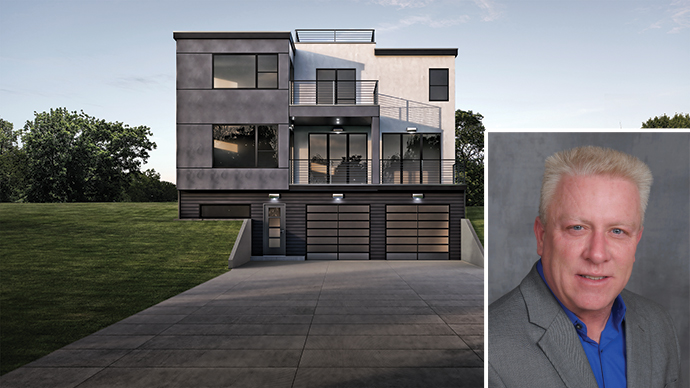When California Governor Gavin Newsom delivered his State of the State address to the California Legislature in February, he devoted a few words to the usual "strong and getting stronger" cheerleading: One in seven new U.S. jobs since 2010 have been created in the state, and its 3.8% GDP growth far outdistances U.S. GDP growth of 2.5%.
But nearly 3,500 of the 4,169 words of his prepared speech were devoted to an issue that also has assumed a stronger profile: homelessness.
"Let’s call it what it is, a disgrace, that the richest state in the richest nation — succeeding across so many sectors — is failing to properly house, heal, and humanely treat so many of its own people," he said.
California is nothing if not a land of stark contrasts. In Silicon Valley, according to CoStar, nearly 8 million sq. ft. of office space is currently under construction, with 20 million more sq. ft. approved and awaiting construction. At the same time, some 30,000 people moved out of San Francisco between April and June 2019 as homeownership in the Bay Area reached a seven-year low.
Among measures in Gov. Newsom’s recent executive order to address homelessness is a provision that exempts all shelters and homeless housing from environmental review in Los Angeles. He wants to expand it statewide. "We need more housing, not more delays," he said in February. Yet at the same time, Berkeley and now dozens more communities have implemented strict new regulations designed to purge fossil fuel use (i.e. natural gas) from new homes.
In “10 Takeaways From the 2010s,” Cushman & Wakefield’s Robert Sammons, senior director of northern California research, takes note of many positive indicators, but prefaces them all with the facts about stratospheric costs. "…While much of the economy boomed throughout the 2010s, the cost of living also soared, now ranking only behind Manhattan and essentially tied with Honolulu as second highest in the U.S.," he writes, though noting that Sacramento is a relatively affordable alternative. "Above all other factors, housing cost is at the root of the issue, and while some progress has been made in this area, it remains a difficult and highly complex matter to resolve quickly," he says.
"Certainly, the spectacular rise in our tech-driven market has shone a bright light on us," Sammons writes. "How we solve or attempt to solve the issues of housing, transit and other areas affecting our quality of life will further put us under the microscope in the 2020s."
The S2A Solution
In addition to the state putting its own land forward for housing, other organizations are stepping up. University of Southern California President Carol L. Folt in February announced new affordability policies to make a USC education more attainable for those in need: Families with an annual income of $80,000 or less will attend USC tuition-free, and owning a home will not be counted in the calculation used to determine a student’s financial need.
"We are also pushing for new models of homeless housing — like hotel/motel conversions and pre-fab and tiny homes," Gov. Newsom said in his address, "and as we do, we’ll cut the red tape to get to ‘yes’ on these innovative approaches."

One expanding California company is awaiting a "yes" on its innovative approach, while also building plants in California, creating jobs and conducting a national site search for eight more plants.
S2A Modular, the maker of what it calls "the first electrically self-sustaining, custom and smart-connected ‘GreenLux’ luxury residences and commercial buildings," in February launched a nationwide search for locations to build eight "MegaFactory" facilities to manufacture its modular homes. “With two S2A MegaFactories already under construction, we’re immensely excited to begin the process of selecting eight additional sites to build our next eight facilities — which will create hundreds of jobs and help stimulate local, regional and state economies,” said John Rowland, president and co-founder of S2A.
Rowland tells Site Selection the two factories already under construction are in Patterson (Stanislaus County, in the Modesto metro area) and in Hemet, located in Riverside County. Both areas are known for their logistics and distribution clusters. "S2A is investing roughly $10 million in Hemet (initial set-up) and $15 million in Patterson due to the land being more expensive," he says. "Initially, each factory will employ approximately 100 employees, and when at capacity, upwards of 250 positions per location."
Why those two cities?
"Our leadership team selected Hemet and Patterson due to the warm welcome each of the cities provided S2A from the very first day of engagement," Rowland says. "Other areas/regions that we approached did not reflect the same amount of enthusiasm or interest. The planning, engineering and building departments in Hemet have been amazing to work with — and are big supporters of S2A and our ‘GreenLux’ vision for the United States and the globe. Patterson was a very similar situation. Officials took the time to meet us at one of our live seminars, and from there, the welcome mat was rolled out for us. They presented special incentives, including but not limited to contribution to employee training, fast track of all plans, reduced development impact fees, reduced taxes for the first five years, as well as being as openly supportive of the ‘GreenLux’ vision."
Does that vision from this Palo Alto–based company encompass a solution addressing affordability and homelessness? Yes, it turns out.
"The homeless population within the state of California is a tragedy — and S2A has had several initiatives on the table to help combat this unfortunate situation," Rowland says. The first, called SH1, is currently being reviewed by RADCO, the third-party agency which approves modular housing at the State Level. He says SH1 "will reduce the cost of each home by as much as 80% compared to what local governments are spending per unit for homeless housing. SH1 requires no electrical or gas hook up, reducing the infrastructure cost, and is scalable to as many units as needed. The SH1 units are 100% built in an S2A MegaFactory and are delivered in one piece: no onsite assembly needed again, saving time and money. Quality and sustainability: lower cost, higher standard of living."
Other home models address affordability too, he says, including the entry-line Model A. Coldwell Banker is among the real estate firms endorsing the concept.
"GreenLux doesn’t mean not affordable," he says. "The entire GreenLux vision is based on lowering the cost of living while upping the standard of living — self-sustaining, luxury/designer smart homes that, by nature, are lower cost to build, maintain, etc. Which is why they are immediately seen as higher value long-term vs. traditional, site-built properties. This is what makes these homes unique. As an example of this, we have a community with about 70 units in Southern California, called Bahia Village. These are GreenLux homes for a 55+ community (fixed incomes), with an average price of around $299,000. We’ve proved that our concept works. That entire community is able to sustain itself off the grid, without utility companies.
Rowland says his company is on a fast track and is looking for eight other U.S. locations who can fast-track his plants. It’s an Amazon HQ2-like location sweepstakes on a smaller scale, and already has garnered interest from communities in Tennessee, Nevada, New York and D.C., "all at some level of political clout," says Rowland.
"We are looking for more cities/regions with similar synergy and would welcome S2A – and our vision for better, more sustainable living and working – to their community with open arms," he says. "Cities and counties who can get us to permit the quickest move to the front of the line. We are on a mission and time is of the essence – so we’re looking to partner with areas that can help us fast-track our initiatives so that we can quickly help make a dent in the larger housing crisis."
Moving Off the Nickel
"What becomes of all the little boys who never comb their hair? They’re lined up all around the block on the nickel over there." — Tom Waits
When Tom Waits composed "On the Nickel" for the Ralph Waites film of the same name, he was referring to L.A.’s Skid Row, found along Fifth Street. Now Skid Row has been cloned many times over across the state, part of a larger affordability problem that plagues most socio-economic strata. It’s a workforce quality of life issue for residents trying to make payments and for growing companies wanting to position or expand operations in the state. That’s why Apple just pledged a few of its own nickels to tackle the problem.

One day before election day in November, Apple announced a $2.5 billion plan to address housing availability and affordability in its home state, noting that teachers and first responders could hardly afford to live in the communities they serve. “Affordable housing means stability and dignity, opportunity and pride," said Tim Cook, Apple’s CEO. "When these things fall out of reach for too many, we know the course we are on is unsustainable, and Apple is committed to being part of the solution.”
Among its commitments:
- A $1 billion affordable housing investment fund will provide the state and others with an open line of credit to develop and build additional new, very low- to moderate-income housing faster and at a lower cost.
- A $1 billion first-time homebuyer mortgage assistance fund will provide aspiring homebuyers with financing and down payment assistance. Apple and the state will explore strategies to increase access to first-time homeownership opportunities for essential service personnel, school employees and veterans.
- Apple-owned land worth $300 million will be made available for affordable housing development in San Jose.
- In a public-private partnership, Apple is launching a new $150 million affordable housing fund with partners including Housing Trust Silicon Valley.
- Apple will donate $50 million to support Destination: Home’s efforts to address homelessness in Silicon Valley.
“This unparalleled financial commitment to affordable housing, and the innovative strategies at the heart of this initiative, are proof that Apple is serious about solving this issue. I hope other companies follow their lead,” said Gov. Newsom. “The sky-high cost of housing — both for homeowners and renters — is the defining quality-of-life concern for millions of families across this state, one that can only be fixed by building more housing."

